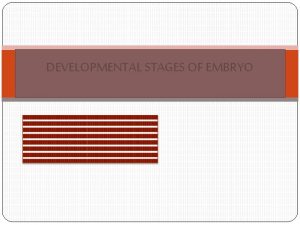The Japanese Macaque Development Developmental Stages infantile juvenile

















- Slides: 17

The Japanese Macaque

Development � Developmental Stages: infantile, juvenile, adolescent, subadult, and elderly Infantile: first year of life � Juvenile: after weaning until reproductive maturity � Adolescence: begins with reproductive maturity � Adulthood: when physical growth if finished � Maximum life span for females is 30 years old and 25 years old for males. � Many females have a few years of post-reproductive life �

Foraging Behavior Although Japanese macaques at one time were not know to raid crops, more recent studies have found that they will raid crops and gardens. Japanese macaques will eat almost anything they have a chance to as long it it’s not too hot or bitter. Common food items include leaves, fruit, seeds, flowers, insects and even bark when resources are scarce.

Classic Macaque Behaviors � Sweet potato washing: They prefer salt water over fresh water � Hot spring bathing: Common among high ranking females � Stone handling: 45 different patterns have been observed

Methods � 8 members of the subspecies Macaca fuscata � 5 females and 3 males � The dominant male was missing a large area of fur on his back. � He was the bold one in the troop.

The Island

Methods � Observations were made on April 30, 2013. Scan sampling: five minute intervals between 11: 05 AM and 12: 30 PM and between 3: 20 PM and 4: 00 PM. Ten minute scan intervals were conducted between 1: 00 PM and 2: 30 PM. � Focal sampling: five ten minute samples for the dominant male, eight five minute samples for the others. � Ad libitum: any interesting behaviors observed were recorded. �

Hypothesis �The dominant male will be observed eating more, getting groomed more, and grooming others less than the other Japanese macaques.

Ad libitum Results � A total of 103 behaviors were observed. Eating was the most common behavior observed with 44 observations. � The second most common was digging in the ground with 20 observations. � The third most common by grooming one’s self with 11 observations. �

Unusual Foraging Behavior � One Japanese macaque was observed eating paper. The paper was soggy from the stream. � Thin strips were torn off before being eaten or tossed into the stream. � No other food items were observable. � It was common to see a macaque dig in the ground and eat whatever it was they found. � Eating was also observed during or after grooming. �


Scan Sampling Results A total of 137 behaviors of Japanese macaques were observed during scan sampling. � The most common behavior observed was resting with a total of 77 observations. � The second most common behavior was locomotion with 33 recordings. �


Focal Sampling Results Dominant Male: 1. 24 changes/min � 23 resting, 20 locomotion, 13 eating, 2 getting groomed, 0 grooming another � Not dominant male: . 675 changes/min � 10 resting, 11 locomotion, 1 eating, 0 getting groomed, 1 grooming another �


Discussion The hypothesis in the present study was that the dominant male would be observed eating more, getting groomed more, and grooming others less during focal sampling. All three points of the hypothesis were confirmed although no statistical analysis was conducted to determine whether or not the data reached statistical significance.

Limitations Unequal time durations in focal sampling. � Relatively short observations for both the dominant male and the non-dominant Japanese macaques. � The results for grooming were also hard to assess due to the low frequency of observations. � Future studies could provide more insight by increasing the number of observation hours and performing observations on more than one day. �
 Developmental views of delinquency
Developmental views of delinquency Erikson vs maslow
Erikson vs maslow Erikson developmental stages
Erikson developmental stages Kellogg drawing stages
Kellogg drawing stages Ego centerism
Ego centerism Cfam developmental stages
Cfam developmental stages Infantile nystagmus
Infantile nystagmus Percezione sincretica
Percezione sincretica Definition de maladie infantile
Definition de maladie infantile Infantile swallowing pattern
Infantile swallowing pattern Botulisme infantile
Botulisme infantile Infantile swallowing pattern
Infantile swallowing pattern Infantile colic criteria
Infantile colic criteria Neuropsichiatria infantile unimc
Neuropsichiatria infantile unimc Nutrible
Nutrible Infantile scoliosis casting
Infantile scoliosis casting Infantile polycystic kidney
Infantile polycystic kidney Deglutizione atipica esercizi
Deglutizione atipica esercizi

































